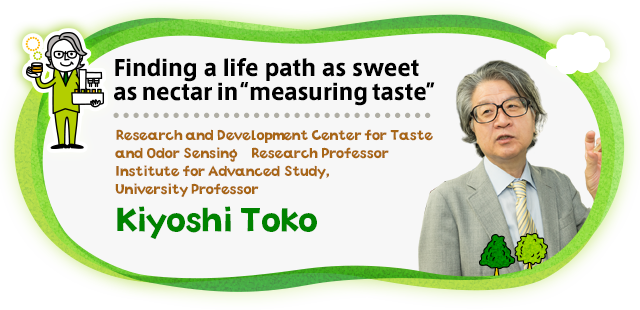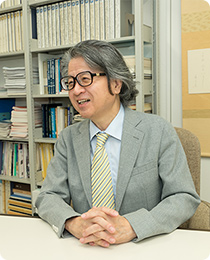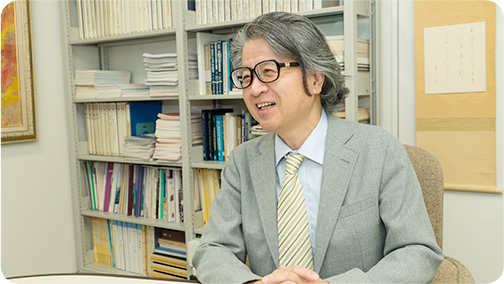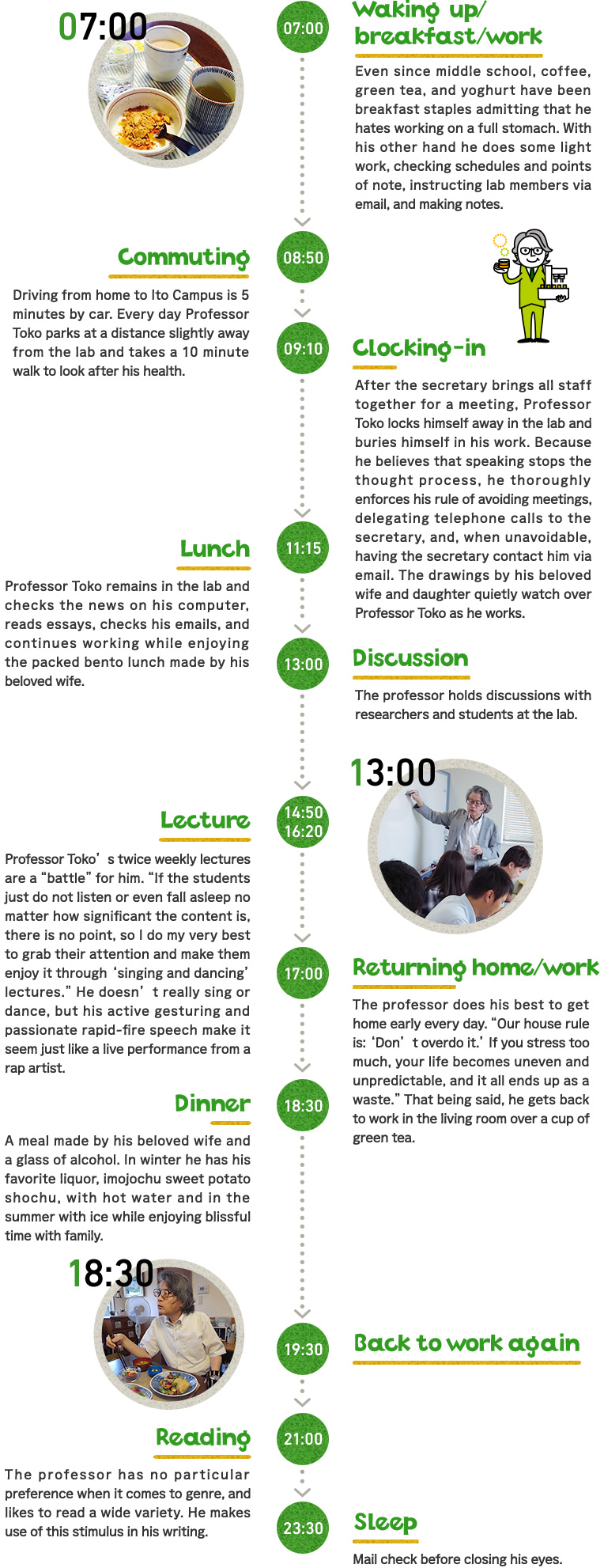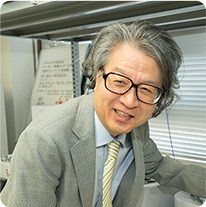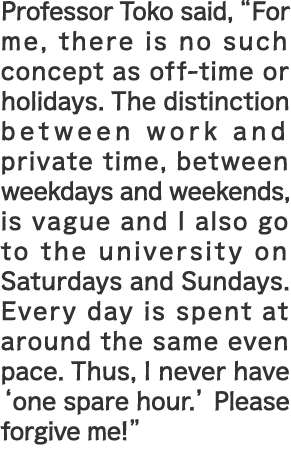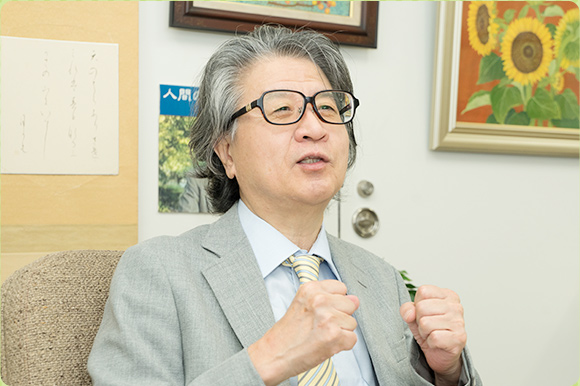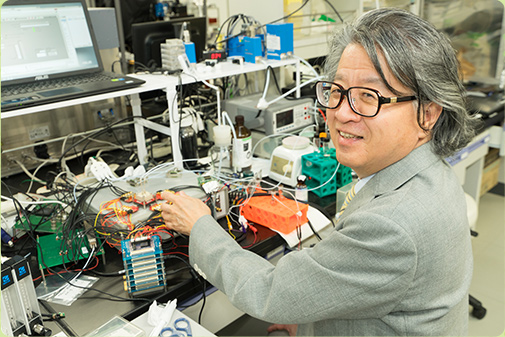 Professor Toko giving an explanation while operating a device.
Professor Toko giving an explanation while operating a device.
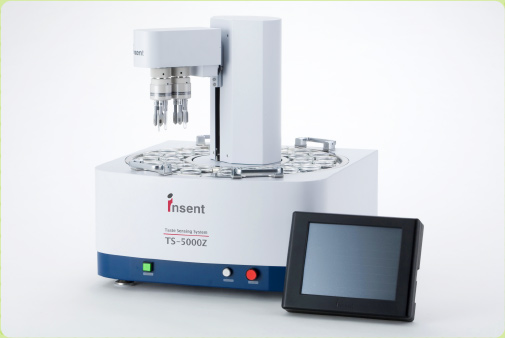 Taste sensing device TS-5000Z.
Taste sensing device TS-5000Z.
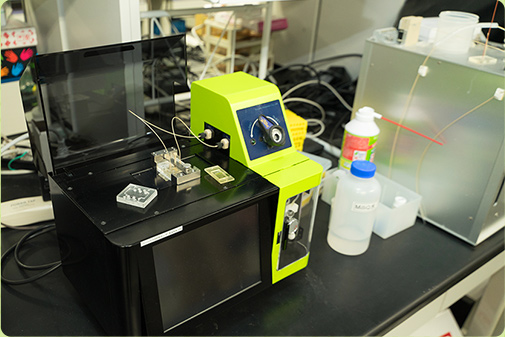 Personal SPR sensor RANA.
Personal SPR sensor RANA.
 Professor Toko giving an explanation while operating a device.
Professor Toko giving an explanation while operating a device.
My specialization is material science—that is to say the field of electronic materials properties—and research into bioelectronics and taste and odor sensing. Of the things I have come up with, the one I like to brag about most is the concept of "measuring taste" and the taste sensor measurement device for such. For many years it was said that "the taste that human beings feel subjectively cannot be measured," but taking the engineering approach that "taste is a reaction of the nerves" I was able to scientifically elucidate and imitate the organic system through which human's perceive taste, and succeeded in developing a taste sensor using artificial lipid membranes. After that, venture enterprises (Intelligent Sensor Technology, Inc. and Taste & Aroma Strategic Research Institute Co., Ltd) were established in order to inherit and implement taste sensor operations. Until today, the sensors have been used at over 400 companies around the world in the development, manufacturing, and quality control of foods and pharmaceuticals, etc. The Kagoshima Highball alcoholic beverage that was released for sale in 2015 is one of these, and was sold inflight on all of All Nippon Airways' domestic routes.
 Taste sensing device TS-5000Z.
Taste sensing device TS-5000Z.
To say that it was family love that produced the taste sensor is no exaggeration. One day during my time as a research assistant, the Hamburg steak my wife made for me was more delicious than usual, and on complimenting her on this, she replied, "I was thinking of your health so I took some of the carrots you hate, cut them up extra small, and mixed them in." Having not realized this at all allowed me to experience the mysteries of taste. Upon researching, I found that there were sensors for sight (light sensors), hearing (microphones), touch (pressure and temperature sensors), and smell (gas sensors, etc.), and of the five senses it was only taste for which no sensor had been developed. In "measuring taste" I found a path for myself as a researcher that was as sweet as nectar.
 Personal SPR sensor RANA.
Personal SPR sensor RANA.
My research base is the Research and Development Center for Five-Sense Devices on the Ito Campus. The five departments of engineering, physical science, medical science, agriculture, and dentistry together with the Kyushu University Hospital form an organization that goes beyond the divide between the study of letters and science in organic cooperation in research into an extremely wide range of fields, making it unique even worldwide. Here, various types of research/projects are underway in the practical development of taste sensors (e-tongues) and odor sensors (e-noses). As a new personal project, in 2016 I tried my hand at giving online lectures titled "Science and Technology of Taste and Odor" through the Japan Massive Open Online (JMOOC)* system. After reviewing the video for transmission several times in advance, I was once again reminded of just how annoying my voice (and personality) are (! bitter laughter), but I ended up being boastfully pleased that the lecture format and content were imbued with a pleasant sense of presence and realism. In the future, too, I hope to do my very best in spreading widely throughout the world the science and technology of taste and odor that was developed by Kyushu University.
*JMOOC
JMOOC is an abbreviation for The Japan Open Online Education Promotion Council (and its Japan Massive Open Online Courses)—an organization that was formed in 2013 with the aim of spreading and magnifying the Japanese version of the originally American "MOOC" (an educational service that provides massive-scale open lectures that anyone can access for free online and issues evidence of course completion for learners).


Sense of taste is a topic of research that is grabbing very wide global interest in terms of food culture—in the micro sense from the perspective of chemical substances, and in the macro sense from the perspective of body and cell studies. Moreover, as someone with an interest in the idea of what it is that makes a human "human"—to the extent of formerly having considered moving into the study of philosophy—it also fulfils my intellectual curiosity. For example, each of the five taste sensations of sweet, bitter, sour, umami savoriness, and salty have their own meaning, and human beings perceive poisonous components as "bitter" and energy sources such as proteins and starches as "sweet."
When it comes to bitter things, babies, too, find even unicellular organisms like Paramecium caudatum and ameba distasteful, but as humans become adults they come to drink things like bitter beer. Don't you think that is strange? Where is it that humans and other animals are the same and where are they different? For me, the possibility of this sort of investigation into humankind and research into psychology is one of its greatest charms.

![]()




